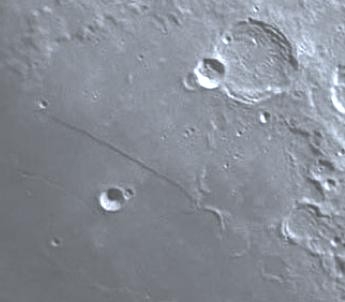, also known as the straight wall. The length of this wall is about 130 kilometers and its height is 366 meters. This cliff rises at the steepest angle on the surface of the moon (41 degrees).
Tammy Plotner and Jeff Barber, Universe Today

Today in 1991 the Compton telescope was launched to observe space in the gamma ray field. It is named after Arthur Hawley Compton, winner of the Nobel Prize in Physics. CGRO scanned the sky in the field of electromagnetic radiation that lies beyond what the eye can see. Such energies erupt at high intensities as a kind of violent explosions that occur in the universe.
Take the telescopes and look at the moon. In its southern half, near the line of light is Rupes Recta, also known as the straight wall. The length of this wall is about 130 kilometers and its height is 366 meters. This cliff rises at the steepest angle on the surface of the moon (41 degrees).
In today's light conditions it will be a challenge, but look for the three crater rings — Ptolemy, Alphonsus and Arzachel. The straight wall appears as a thin line stretching along the edge of the mare nubium.
Stay alert for the meteor shower coming out of Delta Draconid. Its radiant is near the border with Cepheus towards the east. The fall rate is low - about 5 meteors per hour.
Even when the moon is in the sky, you should watch the open cluster west of Origa. The cluster, NGC 2281 should be visible as a nebula in binoculars on a dark night, but an extremely powerful telescope is needed to darken the sky enough to see the bright stars at the center of the nebula. NGC 2281 is 150 light years away and is 50 million years old. It can be found if a line is drawn from Capella to Beta Origa to the same distance to the east as a pair of stars. The nebula is less than a mile east of 58 Auriga, the eastern star of the two.
Universe Today website
